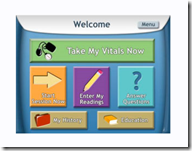I’m not real sure on how many of these we need, but the field continues to grow. We have on more to add to the list. Intel recently began ![]() marketing their product and last week Intel and GE stated they were going to work together on home monitors, so maybe there won’t be as many after all…well probably not, we are going to end up with a Super Home Monitor before it is all over, one that does dishes too. Life at home will just be one big monitor, but the question is, can we stand all of this information at once, time will tell.
marketing their product and last week Intel and GE stated they were going to work together on home monitors, so maybe there won’t be as many after all…well probably not, we are going to end up with a Super Home Monitor before it is all over, one that does dishes too. Life at home will just be one big monitor, but the question is, can we stand all of this information at once, time will tell.
Actually many devices make it much easier than having to write down items by hand or type, so in that essence, the tracking is good and makes life simple, but just like everything else today; so my fear is when the devices begin following me around the house and checking on me, reminding me to take my pills, blood pressure, etc. and it will probably get to that point with sending a picture back to someone who wants to know if I took my pill, like an insurance carrier who will cancel me without the daily picture on file. I like technology a lot, but worry a lot too about intrusive technology and how devices are used and implemented, what are the strings attached for risk management? Is the machine someday going to win and I lose? Here’s one example with Aetna and a device with a pill lottery so you know I’m not totally out of the realm here.
Aetna "Take your Pill" Lottery...
Risk management likes devices and insurance companies tend to be investing in much of this type of technology. BD
The U.S. Food and Drug Administration has approved home monitoring devices from ExpressMD Solutions, Berkeley Heights, N.J.
The Electronic House Call monitors enable patients with chronic conditions to access educational materials and reminders, measure their vital signs and transmit the information to a data center. Providers can then access the data via a Web site.
From the website:
Electronic House Call™

Electronic House Call is an advanced vital signs monitoring system and the main communication device in the patient’s home or care facility. This self-contained home unit is perfectly suited for patients that require frequent assessment and reminders. Simple onscreen instructions make it exceptionally easy for patients to use without care provider assistance, so the practitioner can remotely assess the patient’s condition from the results and make timely adjustments to the care plan. It allows manual entry or automatically takes vital signs from peripherals (both wired and wireless devices are available) and communicates with the practitioner for analysis and intervention.
Related Reading:




0 comments :
Post a Comment